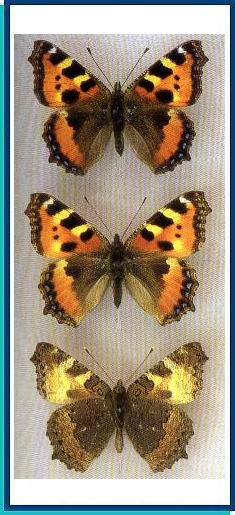LEPIDOPTERA
N Y M P H A L I D A E Swainson, 1827
AGLAIS Dalman, 1816
Aglais urticae (Linnaeus, 1758)
Aglais urticae (Linnaeus, 1758)

• TYPE LOCALITY. [Sweden].
• RANGE Entire Europe, Asia Minor and Central Asia, Siberia to the Pacific Ocean; China, Mongolia, Korea.
• DISTRIBUTION AND VARIATION. Occupying the entire territory concerned, except for the extreme north. Considerable individual and seasonal variability has been the reason for the erection of a lot of infrasubspecific categories. Besides this, a high migratory activity contributes to permanent "agitation" of different geographical races. Because of this, is appears difficult to separate genetically stable forms from casual deviations. Nonetheless, for the time being it seems possible to distinguish the following subspecies: the nominotypical subspecies, occupying the central part of Europe and Siberia to the Altais in the east. The ssp. polaris Staudinger, 1871 is distributed in the northernmost parts of Europe, Siberia and the Far East, being characterised by the black and yellow markings on the UPF, the extent of the dark basal area on the UPH, and the not so bright red ground colour. However, specimens similar to the above pattern can be found in the Altais, the W. Tian-Shan and some other parts of the range. Observations in Scandinavia (Henriksen & Kreitzer, 1982) have shown that, in warm years, only 15% of the population belong to polaris. The ssp. turcica (Staudinger. 1871) is distributed in the S. European part, the Caucasus and Transcaucasia, the Kopet-Dagh and Middle Asia. The ssp. baicalensis (Kleinschmidt, 1929), which habitually looks like the nominotypical form, occurs in the Sayan Mts. and Transbaikalia. The ssp. eximia (Sheljuzhko, 1919) (= ussuriensis (Kleinschmidt, 1929); = mandschuriensis (Kleinschmidt, 1929)) flies in the Amur and Ussuri regions. The latter form is somewhat larger and more strongly contrasting. From the adjacent territories of China, the ssp. stoetzneri (Kleinschmidt, 1940) (TL: Szetschwan = Szechuan) and kansuen-sis (Kleinschmidt, 1940) (TL: NW. China) are known.
• HABITATS AND BIOLOGY. Open landscapes with Urtica brushwood. In the mountains, up to 3,500-4,000 m a.s.l. Often met with in towns and villages. Flight period: April to September, in the south sometimes partly in two generations. Host plants: Urtica dioica, U. wens, U. angustifolia, sometimes Humulus lupulus, Cannabis saliva. Eggs laid in groups of 30-80 on the lower surface of leaves. Larvae gregarious. Butterflies with 1-2 generations, depending on latitude. Hibernation imaginal. Active migrant.
• SIMILAR SPECIES. Aglais connexa: black spot at anal margin of FW merged with median spot. A. rizana, A. nixa, A. cashmirensis: UNF black.
Photo and text: Guide to the BUTTERFLIES OF RUSSIA and adjacent territories Volume 2. PENSOFT, Sofia - Moscow. 2000